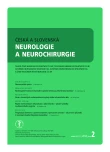Congenital Central Hypoventilation Syndrome (Ondine‘s Curse)
Authors:
T. Matějek 1; M. Šenkeříková 2; E. Ruszová 2; J. Malý 1
Authors place of work:
Dětská klinika LF UK a FN Hradec Králové
1; Oddělení lékařské genetiky, FN Hradec Králové
2
Published in the journal:
Cesk Slov Neurol N 2015; 78/111(2): 215-219
Category:
Kazuistika
Summary
Congenital central hypoventilation syndrome (CCHS) is a rare, lifelong disorder of the breathing centre, resulting from a mutation of the PHOX2B gene. CCHS typically manifests in newborns with alveolar hypoventilation/ apnea during sleep. Clinical severity of hypoventilation and a risk of associated conditions (Hirschsprung disease, tumors of neural crest and autonomic nervous system dysfunction) depend on the type of the PHOX2B gene mutation. Approximately 90% of individuals with the CCHS phenotype are heterozygous for the PARMs‑type mutation (Polyalanine Repeat Expansion Mutations), the remaining 10% of patients express heterozygous missense‑ , nonsense‑ or frameshift‑type mutation (non‑PARMs). Significant hypoventilation leading to severe hypercapnia and hypoxemia was observed in two of our newborns with proved CCHS during the first week after birth. Following a very short period of mechanical ventilation, we succeeded in maintaining physiological blood gases with noninvasive ventilation during sleep. With modern techniques for home ventilation and follow up at specialized centres, children with CCHS have good long‑term prognosis and low mortality.
Key words:
central hypoventilation – Ondine‘s Curse
The authors declare they have no potential conflicts of interest concerning drugs, products, or services used in the study.
The Editorial Board declares that the manuscript met the ICMJE “uniform requirements” for biomedical papers.
Zdroje
1. Weese‑Mayer DE, Berry‑ Kravis EM, Ceccherini I, Keens TG,Loghmanee DA, Trang H. An official ATS clinical policy statement: Congenital central hypoventilation syndrome. Am J Respir Crit Care Med 2010; 181(6): 624– 644. doi: 10.1164/ rccm.200807‑ 1069ST.
2. Amiel J, Laudier B, Attie‑ Bitach T, Trang H, de Pontual L,Gener B et al. Polyalanine expansion and frameshift mutations of the paired‑like homeobox gene PHOX2B in congenital central hypoventilation syndrome. Nat Genet 2003; 33(4): 459– 461.
3. Berry‑ Kravis EM, Zhou L, Rand CM, Weese‑Mayer DE. Congenital central hypoventilation syndrome: PHOX2B mutations and phenotype. Am J Respir Crit Care Med 2006; 174(10): 1139– 1144.
4. Weese‑Mayer DE, Marazita ML, Berry‑ Kravis EM, Patwari PP. Congenital Central Hypoventilation Syndrome. GeneReviews™ [online]. Available from URL: http:/ / www.ncbi.nlm.nih.gov/ books/ NBK1427.
5. Healy F, Marcus CL. Congenital central hypoventilation syndrome in children. Paediatr Respir Rev 2011; 12(4): 253– 263. doi: 10.1016/ j.prrv.2010.10.001.
6. Gronli JO, Santucci BA, Leurgans SE, Berry‑ Kravis EM, Weese‑Mayer DE. Congenital central hypoventilation syndrome: PHOX2B genotype determines risk for sudden death. Pediatr Pulmonol 2008; 43(1): 77– 86.
7. Vanderlaan M, Holbrook CR, Wang M, Tuell A, Gozal D.Epidemiologic survey of 196 patients with congenital central hypoventilation syndrome. Pediatr Pulmonol 2004; 37(3): 217– 229.
8. Kam K, Bjornson C, Mitchell I. Congenital central hypoventilation syndrome; safety of early transition to non‑invasive ventilation. Pediatr Pulmonol 2013; 49(4): 410– 413. doi: 10.1002/ ppul.22848.
9. Nováková Z. Fyziologické zvláštnosti dětského věku. Prakt Lékaren 2012; 8(6): 279– 282.
Štítky
Dětská neurologie Neurochirurgie NeurologieČlánek vyšel v časopise
Česká a slovenská neurologie a neurochirurgie

2015 Číslo 2
- Metamizol jako analgetikum první volby: kdy, pro koho, jak a proč?
- Nejčastější nežádoucí účinky venlafaxinu během terapie odeznívají
- Pregabalin je účinné léčivo s příznivým bezpečnostním profilem pro pacienty s neuropatickou bolestí
- Moje zkušenosti s Magnosolvem podávaným pacientům jako profylaxe migrény a u pacientů s diagnostikovanou spazmofilní tetanií i při normomagnezémii - MUDr. Dana Pecharová, neurolog
Nejčtenější v tomto čísle
- Agresivní hemangiom obratle
- Neuromyelitis optica
- Kongenitální centrální hypoventilační syndrom (Ondinina kletba)
- Radiologické hodnocení lumbální spinální stenózy a jeho klinická korelace
